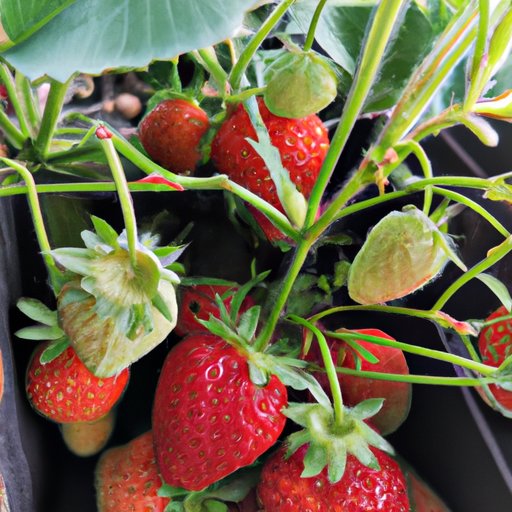
Introduction
Strawberries are a popular fruit known for their delicious taste, versatility, and numerous health benefits. They are rich in vitamin C, fiber, antioxidants, and other essential nutrients that help boost immunity, improve digestion, and lower the risk of chronic diseases. Growing strawberries from seeds is a practical gardening activity that yields fresh and delicious fruit, regardless of the size of your garden. In this guide, we will walk you through the process of growing strawberries from seeds, from materials and equipment to nurturing techniques, to ensure a bountiful harvest.
Materials and Equipment
To grow strawberries from seeds, you need to have the following materials and equipment:
- Strawberry seeds
- Potting soil
- Seed trays or pots
- Fertilizer
- Watering can or sprayer
- Grow light or sunny window
- Plastic wrap or clear lid
When selecting potting soil and containers, make sure they have good drainage to prevent waterlogging, which can cause root rot and fungal diseases. You can use a mix of peat moss, vermiculite, and perlite to create a well-draining soil. Seed trays or pots should be at least 2-3 inches deep and have drainage holes at the bottom. You can also use recycled containers like egg cartons or milk jugs, but make sure to cut holes for drainage.
Watering is crucial for healthy growth of the strawberries, so make sure you have a watering can or sprayer that distributes water evenly without disturbing the seeds. A grow light or sunny window is essential for indoor planting, as strawberries require at least 6 hours of direct sunlight per day to thrive. A plastic wrap or clear lid will help retain moisture and heat, creating a greenhouse effect that speeds up germination.
Planting and Germinating Strawberry Seeds
Planting and germinating strawberry seeds require patience and attention to detail, but the process is simple and straightforward if you follow these steps:
- Fill the seed tray or pots with potting soil, making sure to leave some space at the top to allow for watering.
- Moisten the soil by misting it with water until it’s evenly moist but not soggy.
- Place the seeds evenly on top of the soil, leaving about an inch of space between each seed.
- Cover the seeds with a thin layer of soil or vermiculite, just enough to cover the seeds and keep them from drying out.
- Mist the soil with water again, gently, until it’s evenly moist.
- Place a plastic wrap or clear lid on top of the tray or pots, creating a mini greenhouse that helps retain moisture and heat.
- Place the tray or pots in a warm, bright spot or under a grow light, maintaining a temperature of around 70-75°F.
- Check the soil regularly and mist it with water when it starts to dry out, but avoid overwatering, which can cause fungal diseases.
- After 2-3 weeks, the seeds should start to germinate, and small green shoots should emerge from the soil.
At this point, you can remove the plastic wrap or clear lid and move the tray or pots to a sunny window or under a grow light, keeping the soil evenly moist but not soggy. Make sure to thin out the seedlings or transplant them to individual pots when they are 2-3 inches tall, leaving only the healthiest and strongest ones. This ensures that each plant has enough nutrients and space to grow into a healthy strawberry plant.
Favourable Conditions for Growing Strawberries
Strawberries require specific environmental conditions to grow healthy and produce fruit, both indoors and outdoors. These conditions include:
- Temperature: strawberries prefer mild temperatures between 60-80°F during the day and 40-60°F at night. Too much heat can cause the plants to wilt, while too much cold can damage the flowers and fruit.
- Humidity: strawberries prefer moderate humidity levels between 50-70%, which help keep the soil moist and allow the plant to absorb nutrients. Too much humidity can cause fungal diseases, while too little can dry out the plant.
- Sunlight: strawberries require at least 6 hours of direct sunlight per day to grow healthy and produce fruit. If you grow them indoors, make sure to use a grow light that mimics natural sunlight or place them near a sunny window.
- Soil nutrients: strawberries require a pH range of 5.5-6.5 and balanced nutrients, including nitrogen, phosphorus, and potassium. You can fertilize the plants every 2-3 weeks with a balanced fertilizer or compost tea.
To maintain these conditions, you need to provide proper care for the strawberries, such as:
- Watering: water the strawberries regularly, aiming for about an inch of water per week. Make sure to water the soil around the plant, not the leaves, and avoid overwatering, which can cause root rot and fungal diseases.
- Mulching: mulch the soil around the strawberries to retain moisture and prevent the growth of weeds. You can use straw, wood chips, or leaf litter as mulch.
- Pest control: prevent pests like slugs, snails, birds, and rabbits from attacking the strawberries by placing netting or fencing around them. You can also use natural pest control methods, such as diatomaceous earth, neem oil, or soap spray.
Conclusion
Growing strawberries from seeds is a fun and rewarding activity that yields fresh and delicious fruit with numerous health benefits. By following the steps outlined in this guide, you can successfully grow your strawberries, whether you are a beginner or an experienced gardener. Remember to provide the right materials and equipment, plant and germinate the seeds carefully, maintain favourable conditions for growth, and control pests and diseases, and you will soon enjoy a bountiful harvest of tasty strawberries. Fun fact: Did you know that on average, each strawberry has about 200 seeds on its surface? That’s a lot of potential for growing more strawberries!





